- Home
- Helen Humphreys
Machine Without Horses Page 2
Machine Without Horses Read online
Page 2
“Welcome!” he says, spreading his arms wide in what I first mistake for the expectation of a hug and then realize is just a magnanimous gesture. He is wearing khaki shorts that have creases down the front from being ironed and a clean white quick-dry shirt with the sleeves rolled up. It is nine o’clock in the morning and he is already sweating.
I open the back door of the car and Charlotte bounds out, totally ignoring Paul and hurtling over the parched grass to the lake, where she throws herself off the dock with abandon into the shallow, reedy water. She emerges covered with mud and streaks of algae, shaking herself vigorously at the lake edge, then immediately gets down to the serious business of hunting frogs.
Paul has a dismayed expression on his face, watching Charlotte nosing through the weeds.
“You said I could bring her,” I say, which sounds petulant and ruder than I mean it to.
“I know. It’s just . . .” Paul trails off, his eyes still on the dog’s movements.
“I’m sorry,” I say. “I just couldn’t leave her alone all day. She’ll stay outside. She prefers that.”
Paul leads me, reluctantly it seems, into the bungalow. It’s noticeably cooler indoors, the whir of the window air conditioner like a jet engine.
The house is decorated like a fussy old person’s house, with frills and wallpaper borders and cute sayings on the walls. Home Is Where the Heart Is. New Friends Are Silver, Old Friends Are Gold. There are knick-knacks on every surface, but it is not disordered, just cluttered.
I think that Paul might live with his mother, even though he seems to be in his early fifties, like me. There is, however, no sign of another human being in the house.
“I tie my flies in the basement,” he says, and I follow him through a dark panelled hallway to a rickety set of basement stairs at the back of the house.
This is clearly his domain. I can’t imagine an old person negotiating the twisted rack of stairs or ducking under the low-hanging beams. He definitely lives with his mother, I think. It is classic child to escape to the basement—sadly, even a child in his fifties.
It is cooler underground. Paul leads me to a long table buttressed up against the far wall.
“I tried to clean up,” he says, “but it’s a messy hobby.” He waves his hand over the feathers and spools of thread, the open boxes of what look like animal pelts.
“Please.” He pulls out a chair for me, and when I sit down, he sits down right next to me.
It feels awkwardly like a date for the first few moments, until he hands me a vise, shows me how to clamp it onto the tabletop, next to his vise.
“If we are side by side, then you can see exactly what I’m doing,” he says, switching on a standing lamp. “It’s the best way to learn.”
I think of the photo of Megan Boyd sitting next to her dog at her workbench. I am clearly the dog in this scenario.
“I read about your lady,” Paul says. “Seems she was quite the legend in salmon fly circles.”
“One of the best,” I say.
Paul wipes his palms and forehead with a small orange towel, then folds it carefully and puts it down next to his glasses case on the far right-hand side of the table.
“Well,” he says, “unfortunately, I am not one of the best, so I won’t be able to help you tie flies like she could. But I think I can break down the process for you, and maybe that will help.”
“Anything will help,” I confess. “I’m trying to work my way inside her mind before I write about her.”
“Very interesting.” Paul draws out the word very. He passes me a bobbin of black thread. “This is what we use to tie all the materials onto the hook. But first, we lay down a base layer of thread to cover the metal. All we’re going to do this morning is work on laying down the thread. Practice will build confidence, and the base layer needs to be applied with confidence, but not so much that you disregard what it is you are doing.”
This seems like good advice for almost anything in life, and I am relieved that he is teaching me to tie flies in manageable segments. This is also how I like to write, never looking too far into the distance in case I become overwhelmed by the magnitude of work that lies ahead.
Tying flies is, of course, harder than it looks, and requires keeping a consistent tension on the hand that controls the bobbin, to ensure that the thread wraps around the hook with an even tautness and doesn’t overlap.
I wind the thread on the hook, then unwind it, then wind it back on again. Paul checks each time. He is stingy with praise, only saying “better” or “not bad” to signal my progress. After an hour and a half of wrapping and unwrapping the hook, he declares a break, scraping back his chair on the rough cement floor and bouncing to his feet.
“Come upstairs,” he says. “I have some iced tea in the fridge.”
The dog is still after frogs at the edge of the lake, but when she hears the back door open, she comes bounding up onto the porch, barking sharply to reprimand me for disappearing for so long. I rub her ears and she hangs around for a minute or two, then rushes back to the shoreline.
“I don’t really understand dogs,” says Paul, watching her. “I’ve always been a cat person myself.”
“Do you have a cat?” Charlotte likes nothing better than to chase cats. For her, it’s right up there with hunting frogs as one of life’s ultimate pleasures. The thought of the potential carnage makes me nervous.
“Not anymore,” he says. “The last one just disappeared. I think she was eaten by a coyote.” He takes a sip of his tea. “Sophie,” he says a little sadly. “She was a tortoiseshell. Very pretty.”
The word pretty reminds me of Megan Boyd.
“Why do you make flies?” I ask. “Do you fish?”
“Not really. Not anymore.” Paul stirs the ice in his drink. “I like the puzzle of it. Making the different lures, following a pattern. Sometimes I sell them or give them away to friends or neighbours. I’ve always been good with my hands, I guess. I used to make model airplanes when I was young. Complicated ones. I made an aircraft carrier once, with a whole deck load of tiny individual fighter jets.” He takes another sip of iced tea. “Can I ask you a question?” he says.
“Sure.”
“How do you get inside someone’s head to write about them? Especially someone who was a real person?”
This is the sixty-million-dollar question, and one that I don’t really have a definitive answer for because I’m constantly shifting my thinking about how to accomplish this kind of transference. It is hard enough to be oneself. How can we effectively become someone else?
“I suppose I try and level the playing field,” I say. “Occupy as much of their experience as I can. Learning to tie salmon flies, for example. Finding commonalities.”
“But their thoughts?”
“That’s trickier. I have to take a guess at it. But hopefully, by the time I get there, it’s an educated guess and will seem believable because I’ve done the work of learning who Megan Boyd was.”
“Yes.” Paul nods his head in agreement. “That makes sense.”
We go back to the basement and I wind thread for another hour, and then Paul sends me on my way. I am to return every morning for a week, at the end of which time, he promises, I will know how to make a Jock Scott, which is one of the salmon flies that Megan used to tie.
The dog sleeps happily in the air conditioning all the way back to town, her long legs hanging limply over the back seat, her head propped up on the armrest. She never actually catches frogs when she hunts them, isn’t much interested in eating them. She just likes how they move. That’s what attracts her to them. Similar, perhaps, to how a salmon responds to a fly: it likes how the fly moves through or on top of the water. The fisher presents the fly—that is the terminology—as though the fisher is somehow auditioning for the salmon.
That evening, while I’m eating dinner, Paul calls me. He is hesitant on the phone, and it feels strange for him to call me when I will be seeing him the next morning.
“I’ve been giving it some thought,” he says, “and I think you need to look into Megan Boyd’s view.”
“Her view?”
“What she would have seen out her window when she was tying flies. It matters.”
“But you don’t see anything when you tie flies?” I say, thinking of the blank cinder-block wall that faced us when we were sitting in Paul’s basement this morning.
“It matters,” he says again, and then he hangs up.
5.
CANCER.
Cancer.
Cancer.
Cancer.
Cancer.
Cancer. (Even the dog.)
6.
THE SETTING FOR A STORY IS ALMOST AS important as character—in fact, in certain instances, it can operate as a sort of character. So, in thinking about Megan Boyd’s immediate landscape, I have to consider how vital a role it played in her life.
Megan’s cottage in Kintradwell looked out on the North Sea. That was the view she would see when she looked up from her work and out the window in front of where her desk was positioned. But in the foreground, directly outside, was her garden. Friends remembered the garden as being full of flowers, so she must have spent some time tending it. Past the garden was a fence, then the road, then a strip of rail track, followed by a grassy verge, and beyond the verge was the sand and the sea. Look up and see the water, but look down and see the garden, the road, the train tracks. Six times a day, the train would shunt along the rails—half of those journeys going north and half heading back towards Inverness. The road would have had traffic on it fairly constantly, and if Megan had the windows open, she would have been able to hear the cars, the train and, beyond that, the crash of waves onto the shore if the surf was high. That was a lot of activity to layer onto her solitary pursuit of fly-tying, and I wonder if she was so used to all the noise and movement that she effectively blocked it out, or if it interrupted her work. Did she raise her head every time the train went past? Did she listen for the changes in the sound of the sea as it hurled itself against the shingle? How much attention did she pay to the outside world when she was engrossed in tying her salmon flies? Did the constant movement beyond her cottage window make her restless, or did the outside activity make her cleave more solidly to her solitude and stillness?
The main question to ask about setting in a novel is to determine what is private and what is public. What does everyone know about the place where the story is set, and what will only the main character know?
During the Second World War, when Megan Boyd was in her twenties, she helped the war effort by delivering milk and working as a coastwatcher or warden for the little stretch of coastline near her house. One of those activities is inherently social and one is inherently solitary, and I wonder if, in combination, they set the tone for her life to follow. Because although Megan lived in isolation, she was not isolated. She had a lot of visitors to her cottage—fishermen there to buy her flies or to regale her with stories of the catches they had made with those flies. She was also involved in village life, participating in Scottish country dances and helping the young and the elderly. So, she would have had intimate knowledge of where she lived and of the people who lived near her.
A fisherman said that Megan was so used to tying flies that she could do it without looking. That meant she would have often been looking out the window, instead of down at the lure. Those years of volunteering as a coastwatcher, of staring out to sea in search of enemy aircraft or submarines, might have become a habit. But after the war, when she wasn’t looking for trespassing planes on the patch of North Sea beyond her window, what was she looking at? Was the shifting pattern of the water and light enough to keep her attention for decades? Or was it more of a Zen approach, where staring at the sea was a form of meditation while she was working on tying salmon flies?
I have a lot more questions about Megan’s landscape than I can answer, and I wonder, briefly, whether it would be a good idea to go to Brora and look around for myself. But I’m not sure that would do any good because I would be looking at everything with fresh eyes, and so I would only see the “public” face of the area and would not be able to experience Megan’s private view of her surroundings. Also, she has been dead for fifteen years at this point, so things will have changed with her cottage and environs. So, that will be the part of the story that I will have to largely invent, a thought that feels uncomfortable because there are multitudes of ways to get it wrong.
The trouble with writing a novel is that there are so many ways to make mistakes that you just have to give up on the idea of getting it right. Instead, you have to choose a few aspects to remain faithful to and do your best to make everything else as believable as possible for the reader. In this story, I will try to capture Megan’s character and hope for the best as far as the landscape goes. Research and some knowledge of Scotland will hopefully be enough to adequately replicate the landscape around Brora in words.
Although a small town, Brora has an industrial past. Coal was consistently mined there since the sixteenth century, and it was the site of the most northerly coal mine in the British Isles. That mine closed for good in 1974, after over four hundred years of production.
The tiny Brora harbour was home to a herring fishing fleet in the nineteenth century, and there was also textile manufacturing in town, brick and tile plants, and salt production. The harbour was also the location of a boat-building operation. A whisky distillery was introduced to the area in the nineteenth century and still operates there today, and a woollen mill was opened in the early twentieth century, selling upmarket tweed clothing.
The railway came to Brora in 1871 and the radio in 1939, two important connections to the outside world. In its nineteenth-century heyday, when all enterprises were in gainful operation, the population of the town was close to two thousand people. Now it hovers around twelve hundred. In Megan’s day, it would have had a few hundred more people than it does now.
The buildings of Brora, like the buildings of Kingston, where I live, are made of limestone, and there were several limestone quarries in proximity to the town in the nineteenth century. Inhabitants of the town described the dull grey buildings as being depressing in the winter, which is a sentiment uttered in my town as well. But I like to think that the opposite is true. Limestone is made from compressed sea creatures from prehistoric, living seas. The building blocks of both Brora and Kingston are a congress of dead sea creatures from the ancient slip and spill. Each stone older than all of human life.
7.
I FIRST WENT TO SCOTLAND WHEN I WAS IN my early twenties, with my boyfriend at the time. It was early summer and the sky was light late into the evening. We began our journey in Edinburgh and then took the train north to Perth. After that, we hitch-hiked farther east, ending up on our first night in the small coastal village of Crail on the edge of the North Sea. It was a beautiful spot and the day was sunny and flawless. We walked the narrow streets for a while upon arrival, and then went to a pub for supper before heading back to our bed and breakfast for the night.
My boyfriend was someone I had known a long time. We grew up near to each other and were good friends when we were children. I fully expected that I would marry him, and on that trip, on that night in Crail, he asked me to, as we were walking along the harbour wall after our meal. He said, “But sleep on it,” and I agreed.
The next morning, I woke before him, just as it was getting light out. I dressed quickly and left the room, walking back down to the harbour.
It was low tide and there were suddenly all these rock pools along the shore that hadn’t been there the previous day, when the tide had extended right up to the harbour wall. I wandered among the pools, looking at the seaweed and stranded sea creatures. A little way ahead of me, on the foreshore, were two women, slightly older than me, doing exactly what I was doing. They were giddy with laughter, clutching on to each other as they clambered over the slippery rocks, bending down together to peer at
a crayfish or a shell. We were the only people out this early. Above us, the village and, presumably, my boyfriend were still asleep.
I followed the women. I couldn’t help myself. Not wanting to disturb them, I kept a respectful distance, but I stopped watching the tidal pools at my feet and turned my attention on them. What I liked was their laughter and ease with each other, their intimacy. It took me a while to realize that they were a couple, not simply friends, and when I did realize that, I also realized something else. It shocked me to recognize that I wasn’t as happy as they were, and I knew I wanted to be that happy.
I went back to the bed and breakfast and told my boyfriend that I couldn’t marry him.
8.
THERE’S A COW THAT HAS ESCAPED FROM A farm that borders the woods in Kingston where I take the dog to walk. She’s been missing for three weeks now, turning up now and then to be photographed with someone’s phone, but when the farmer goes looking for her, she has disappeared again. She’s large and brown and the one news report I heard about her said that she “should not be approached.” She doesn’t look very scary in the blurry phone photograph that’s online, and I like thinking of her on the lam, maybe joining up with the wild deer that occasionally roam this piece of land.
I meet George and his human near the entrance to the wood.
“Did you hear about the cow?” I ask, while our dogs stiffly renew their acquaintance.
“I have been looking for it,” he confesses. “I mean, how can a cow stay hidden for so long? It’s a big animal and a small wood.”
The presence of something unusual in our usual routines is always startling and exciting. I once saw a buck cross the grass by the river and thought about it for weeks afterwards, the sighting feeling like a sort of magic that I appliqued to everything in my ordinary world.

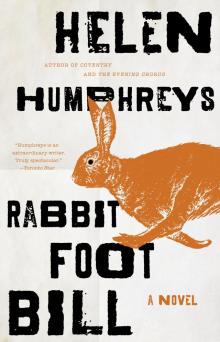 Rabbit Foot Bill
Rabbit Foot Bill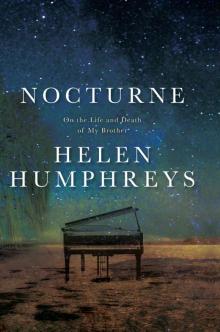 Nocturne
Nocturne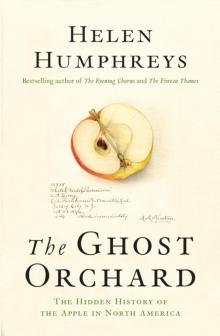 The Ghost Orchard
The Ghost Orchard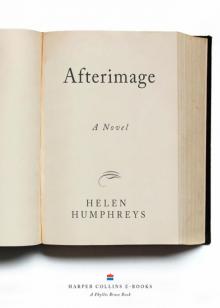 Afterimage
Afterimage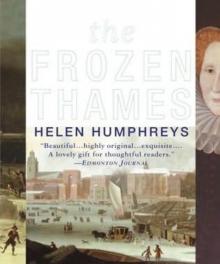 The Frozen Thames
The Frozen Thames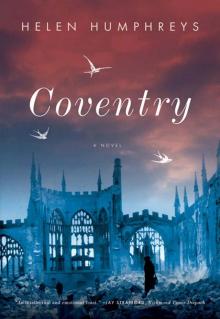 Coventry: A Novel
Coventry: A Novel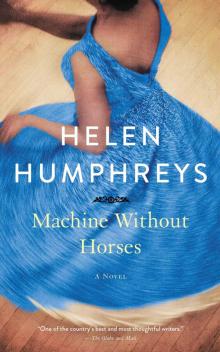 Machine Without Horses
Machine Without Horses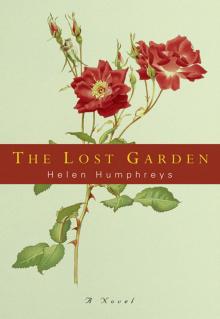 The Lost Garden: A Novel
The Lost Garden: A Novel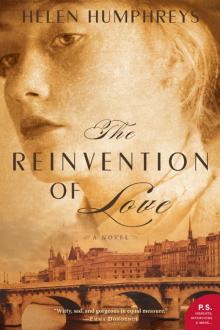 The Reinvention of Love
The Reinvention of Love Helen Humphreys Three-Book Bundle
Helen Humphreys Three-Book Bundle